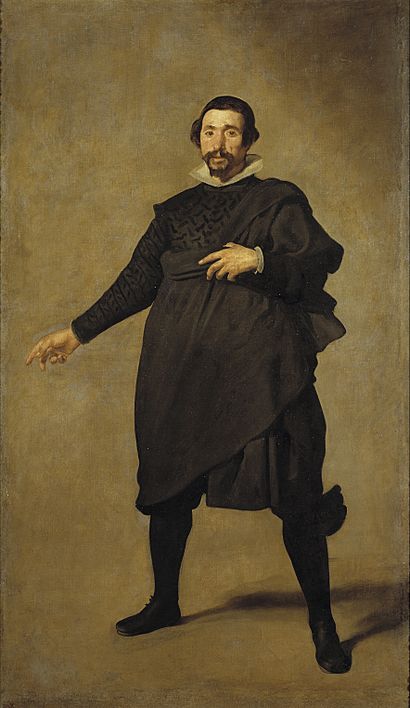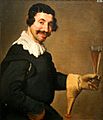Portrait of Pablo de Valladolid facts for kids
Quick facts for kids Pablo de Valladolid orPortrait of a famous actor in the time of Philip IV |
|
|---|---|
 |
|
| Artist | Diego Velázquez |
| Year | c. 1635 |
| Medium | oil on canvas |
| Dimensions | 209 cm × 123 cm (82 in × 48 in) |
| Location | Museo del Prado, Madrid |
Portrait of Pablo de Valladolid is a famous painting by Diego Velázquez. He painted it around 1635. It shows Pablo de Valladolid (1587–1648), who was a jester and actor. Pablo worked at the court of King Philip IV from 1632 until he died. Today, you can see this painting at the Museo del Prado in Madrid. It was moved there in 1827.
Contents
The Painting's Journey Through Time
This painting is one of many portraits Velázquez made of jesters and other entertainers at the royal court. These artworks were meant for less important rooms and hallways in the royal palaces. In these areas, Velázquez had more freedom. He could try out new painting ideas. This was different from the official portraits of the royal family. Those portraits needed to show the royals in the best possible way.
Where the Painting Was Kept
In 1701, the painting was at the Buen Retiro Palace. Records from that time described it as "portrait of a jester with a ruff collar called Pablillo, the one from Valladolid by Velázquez." It was valued at 25 doubloons, which was a type of old Spanish coin.
Later, in 1772 and 1794, the painting was listed in the Royal Palace of Madrid. It was kept with another portrait of a jester, Don Juan de Austria. However, the name of the person in the painting was not mentioned in these records.
Moving to Art Academies and Museums
In 1816, the painting moved to the Real Academia de Bellas Artes de San Fernando. Here, it was known as "Portrait of a mayor." Then, in 1827, it was moved to the Museo del Prado. In the museum's 1828 catalog, it was simply called "Unknown Portrait."
A Famous Artist's View
The French painter Édouard Manet saw the painting during a trip to Spain in 1865. He was very impressed. He wrote to his friend Henri Fantin-Latour about it:
Perhaps the most astonishing piece of painting that has ever been made is the picture entitled Portrait of a famous actor at the time of Philip IV (Pablillos Valladolid). The background disappears. It is air that surrounds the man, dressed entirely in black and full of life.
What the Painting Shows
The painting shows Pablo de Valladolid standing up. His legs are spread wide apart. He is dressed completely in black. With his left hand, he holds his cape close to his chest. His right arm is stretched out, making a gesture as if he is speaking or performing.
The Unique Background
Pablo's shape stands out clearly against a plain background. There is nothing else in the picture to show where his feet are, except for the shadow he casts. Velázquez even left out the faint line that usually separates the floor from the wall in other portraits. If you look closely, you can see where the artist made changes. For example, his left leg was first painted a bit longer.
The Revolutionary Style
Many people think it's amazing that Velázquez painted Pablo without a detailed background. This style was seen as "revolutionary" by art experts like Julián Gállego. It makes the jester look almost like a saint floating in the air, similar to how saints were sometimes painted with a golden background.
The background color has changed over time. It used to be a "luminous grey," according to one expert. But in recent years, it has turned into an "abominable ochre" (a brownish-yellow color). This change happened because of old varnishes and not-so-careful preservation. However, a study by Carmen Garrido found that the original background color was actually brown. This brown color was made from black iron oxides, white lead, and other materials.
Other images of same model
See also
 In Spanish: Pablo de Valladolid para niños
In Spanish: Pablo de Valladolid para niños
- List of works by Diego Velázquez



